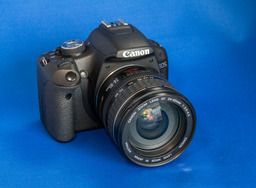Apart from the cameras that are near and dear to our hearts, gear that isn't used regularly can be sold to generate revenue for purchasing new items. My goal is to create a win/win scenario where both seller and purchaser feel good about the transaction.
A successful sale begins when you first purchase the item. By following these easy steps, you'll protect your investment and create a positive selling experience up the road.
Save Original Packing
Save the box, owners manual, cables, software CD, and anything else that's part of the kit. Prospective buyers love original packing. It helps maintain the value of their investment. And it doesn't cost you anything other than setting aside a little storage space.
Hang on to Brochures and Books
Another value-added item is collateral material related to the camera. Printed brochures, books on how to use, and other promotional items enhance the buying experience. Not only will these items help the buyer get more out of their purchase, they add emotional appeal.
Protect the LCD and Lens
The LCD screen and front objective glass of the lens are the most delicate surfaces on the camera. By putting a screen protector on the LCD and a high quality, multi-coated filter over the lens, you'll help protect your investment. When it's time to sell the item, I remove all protection, revealing mint condition surfaces. Believe me, nobody wants to buy a scratched LCD.
Sell the Camera While It Still Has Value
Finding a buyer for a 3-year-old camera is much easier than one that's been around for 5 years. Most buyers plan on using the purchase for their hobby, and they want to feel they have something that's current and desirable. If you know you're going to eventually sell an item, sell it now. Everyone will be happier.
Take a Good Picture, Write a Good Ad
I prefer to sell on Craigslist, at local camera stores, and via local newspapers. I write a descriptive ad without effusive adjectives, and take a good picture of the item I'm selling. I then meet the prospective buyer at a local coffee shop where they can test the gear and ask me questions. This provides a satisfying experience and eliminates buyer's remorse.
Charged and Ready to Roll
When it's time to meet the buyer, charge the battery, put a memory card in the camera, and make sure all systems are go. Show the buyer how to operate the camera, adjust the diopter to their eyesight, and let them take pictures. I like to have a good cup of coffee during this process.
Be Fair, Honest, and Sincere
I think it's really exciting to pair one of my cameras with a new photographer who has the opportunity to flourish with it. When I go to sleep that night, I want to be thinking about how happy they are with their purchase, and how I've taken a positive step toward my new gear goal.
Never, under any circumstance, take advantage of a prospective buyer just to get a few more dollars. Not only is it wrong, but it undermines the entire marketplace for used gear. As I said in the beginning, win/win scenarios are just good business.
Want to Comment on this Post?
You can share your thoughts at the TDS Facebook page, where I'll post this story for discussion.















